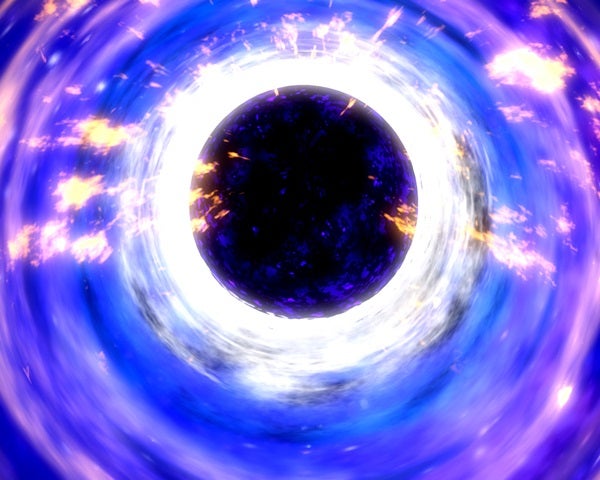Scientists at Rochester Institute of Technology (RIT) have won several grants to extend their own supercomputer and make use of two of the fastest supercomputers in the world in their quest to “shine light” on black holes.
Since light cannot escape from the surface of a black hole, scientists rely upon computer algorithms to study the massive dark objects. Researchers in the Center for Computational Relativity and Gravitation at RIT are using supercomputers on campus and across the country to simulate with mathematics and computer graphics what cannot be seen directly.
“It is a thrilling time to study black holes,” said Manuela Campanelli, center director. “We’re nearing the point where our calculations will be used to test one of the last unexplored aspects of Einstein’s General Theory of Relativity, possibly confirming that it properly describes the strongest gravitational fields in the universe.”
RIT mathematics professors Campanelli, Carlos Lousto, Yosef Zlochower, and Joshua Faber and computer science professor Hans-Peter Bischof study the evolution of black holes and other objects using large-scale supercomputers. Their computer lab hosts “NewHorizons,” a cluster consisting of 85 nodes with four processors each, connected via an Infiniband network that passes data at 10-gigabyte-per-second speeds.
Three National Science Foundation awards have brought the center’s external funding total up to $2.9 million in the past 3 years. The awards — plus time won on a top supercomputer — will dramatically enhance the team’s access to the most sophisticated computer power in the world:
- The team recently won $85,000 from the National Science Foundation’s Scientific Computing Research Environments for the Mathematical Sciences program to augment their computer power by nearly 50 percent with an extra 20 nodes, each containing eight processors. The additional power will help the team develop new algorithms and computational techniques for testing the General Theory of Relativity.
- The RIT group was awarded 3.5 million CPU (computing processing units) hours on the “Ranger” supercomputer through the TeraGrid, the nation’s premier resource for scientific computing, coordinated through the University of Chicago. Ranger, housed at the Texas Advanced Computing Center in Austin, is the eighth most powerful supercomputer in the world, according to the Top 500 List of supercomputer sites, a biannual ranking announced in June at the International Supercomputing Conference in Hamburg, Germany. The RIT award represents the equivalent of using 400 of the computer’s processors round-the-clock for an entire year.
- RIT’s Center for Computational Relativity and Gravitation is one of two relativity groups that won a National Science Foundation (NSF) Petascale Computing Resource Allocation grant reserving time on a “super-supercomputer” called “Blue Waters.” The machine is scheduled to begin production in 2011 at the University of Illinois’ National Center for Supercomputing Applications. Blue Waters, which will consist of more than 200,000 processing cores, is expected to be the most powerful supercomputer in the world for open scientific research. The $40,000 award will support travel to the cluster facility in Champaign, Illinois, and opportunities to collaborate with computer scientists designing the machine.
- The Computer Communication Research Group (CCRG) is helping to shape the next generation of supercomputer power by using available resources in novel ways and developing computational tools to enable new science. The NSF awarded RIT $300,000 as part of a collaborative research project to develop the Community Infrastructure for General Relativistic Hydrodynamics. Scientists will use the open toolkit and cyber infrastructure to model black holes, neutron stars, and accretion disks. RIT researchers Bischof, Campanelli, Faber, Lousto, and Zlochower will work with their colleagues at Georgia Tech, Louisiana State University, Albert Einstein Institute, and Oak Ridge National Laboratory to develop tools for understanding many of the most energetic events observed in astronomy, from millisecond-long bursts of gamma-rays to active galactic nuclei, that constantly emit more than a trillion Suns’ worth of energy.
“Computers are only going to get bigger and faster over the coming years,” said Campanelli, “and with these grants and allocations, RIT’s numerical relativity group should stay at the forefront of scientific computation for years to come.”










